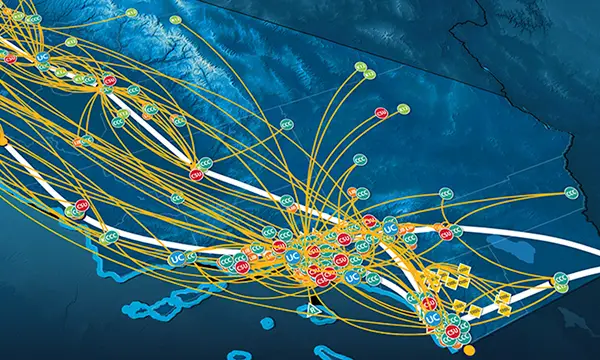- About
- Network
- Community
- Initiatives
- News
- Events
- Blog
- Publications

CENIC on the Path to a Native 800 Gbps California Research and Education Network Backbone
Categories RENS & NRENS Technology & Innovation
Tags 800G pluggables

At the March 2024 CENIC conference, CENIC Network Architect Fady Bekhit and Lead Network Engineer Alaa Shaheen outlined CENIC’s 800 Gigabit per second (Gbps) backbone upgrade program that, with Spectrum Services, would result in a multi-Terabit backbone using less equipment and power than ever before. Now, this has been achieved through multiplexing using Juniper’s coherent pluggable optics, making CENIC one of the first advanced research and education networks to deploy pluggables widely on a production network.
Thanks to its strong relationship with Juniper Networks at the highest levels, CENIC has also begun the process of achieving a native 800 Gbps backbone on geographically suitable segments that typically see heavy use.
In only the latest example of a long history of collaboration on behalf of CENIC member institutions, Juniper collaborated with CENIC to enable the deployment of its top-of-the-line PTX10002 packet transport routers.
The first California Research and Education Network (CalREN) backbone sites slated to be equipped with these routers are the Los Angeles, Sunnyvale, and San Diego backbone hub sites, which will bring the relevant segments of the CalREN backbone up to a native 800 Gbps capacity carried over a single fiber pair.

“Our PTX 800GE platform is setting a new industry benchmark for performance, sustainability, and automation in the AI era. Juniper also continues to innovate with the coherent pluggable optics within our high-end routing portfolio because we see the enormous benefit our customers can derive from the traffic capacity, openness, and operational efficiencies they enable. CENIC’s use case is particularly relevant as a real-world showcase for high-performance, high-bandwidth networking services for the academic research community—the epitome of relentless traffic growth and user demand for reliably super-fast connections,” said Rami Rahim, CEO of Juniper Networks.
Such large increases in CalREN backbone capacity enable faculty members, researchers, and students to access colleagues and vast datasets, as well as the facilities that generate, process, and display them. This increase also bolsters the network's capability to manage higher traffic volumes and offers the potential to create entirely new research and education workflows.
And of course, CENIC member institutions making use of the CENIC AI Resource (CENIC AIR) will benefit greatly—whether as participants contributing compute and storage resources or as research and education users—with increased backbone capacity connecting them to one another, to CENIC AIR itself, to the available resources of the National Research Platform (NRP), and to resources and colleagues around the world.
“I am proud of the CENIC team’s creative and persistent approach to providing one of the most advanced research and education networks in the world to our members. Indeed, we now have progressed to being on the cusp of a native 800-Gigabit backbone, including related Spectrum Services,” said CENIC President and CEO Louis Fox. “We couldn’t do this without a remarkable industry partner in Juniper Networks or without CENIC’s amazing science community who collaborate with us to bring leading-edge resources to help advance research and education. And, last but not least, we are grateful to have visionaries on our board of directors who encourage and support us.”
Long-time readers of the CENIC blog will be familiar with CENIC’s flex-grid Spectrum Services, which enable more capacity over the same pair of fibers with less equipment. This is made possible by combining very small “slices” of the available wavelength of a fiber pair into a single composite “slice.” If used exclusively, Spectrum Services has the potential to increase the upgraded CalREN backbone capacity to over 25 Terabits per second.
Coherent Pluggable Optics Already Boosting CalREN to 800 Gbps
As mentioned above, thanks to wide deployment of pluggable optics, 800 Gbps has in fact already been achieved via multiplexed 400 Gbps for all tiers—both CalREN-DC and CalREN-HPR—with CalREN’s entire Southern Route now effectively operating at 800 Gbps.
CENIC is also in the process of upgrading the remaining major backbone segments, which will result in a full (multiplexed) 800 Gbps backbone for all tiers by the end of this fiscal year in June.
This means that the entire CalREN Southern Route now operates with no transponders, with all segments using two pairs of pluggables for a total capacity of 800 Gbps. This design allows for significant colocation space and power savings, a much simplified network design, and lower backbone router port utilization.

Additionally, by leveraging the capabilities of 400GZR+ pluggables to the furthest extent, CENIC realizes significant savings in capital and operating expenditure compared to similar services configured with discrete transponders.
CENIC has met and overcome many challenges in a timely manner on the way to this achievement including logistics, software limitations on the existing line system and end routers, and flex-spectrum infrastructure availability. With work continuing on the remaining backbone segments, all other upgrades as illustrated in the diagram above will be completed by the end of the 2024–25 fiscal year in June.
We’ll be sure to keep our members up to date on the road to a native 800 Gbps backbone and how you and your colleagues can put CENIC’s network capacity and services to work for your faculty, researchers, and students.
Related blog posts
The Big Game Is Big Data: How CENIC and the California Research and Education Network Support Member Athletics
When Fresno State needed to connect to Pac-12 Enterprises to broadcast a live football game over CBS, the Chancellor's Office reached out to CENIC for what Pac-12 later called the smoothest turn-up they've ever experienced.
Enabling Network-Based Collaboration Around the World: A Tour of CENIC and Partner Network Maps
On the Network Maps page at the CENIC website, you’ll find maps of all the networks, peering facilities, and exchanges to which CalREN connects, showing how thousands of CENIC member institutions connect to CalREN and to colleagues all over the globe.


